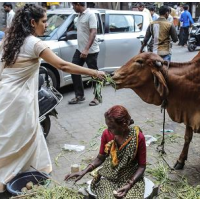India’s Plan to Fight Global Warming: Reduce Cow Belching
 (photo: Dhiraj Singh, Bloomberg/Getty Images)
(photo: Dhiraj Singh, Bloomberg/Getty Images)
By Ellen Barry, New York Times
Let no one say that India is not doing its bit to fight global climate change: Government scientists are working hard to reduce carbon emissions by making cows less flatulent.
Consider the numbers: India is home to more than 280 million cows, and 200 million more ruminant animals like sheep, goats, yaks and buffalo. According to an analysis of satellite data from the country’s space program, all those digestive tracts send 13 tons of methane into the atmosphere every year — and pound for pound, methane traps 25 times as much heat as carbon dioxide does.
So reducing animal flatulence might actually do some good — especially in India, where there is little chance of cutting back the use of fossil fuels anytime soon. (In fact, the country expects to double its coal production by 2019.)
Scientists at the Cow Research Institute in Mathura, around 100 miles south of New Delhi, are tinkering with cattle feed, seeking a formula that will create less gas for the cows to belch out. (That is how most of it is released, by the way; scientists say much less comes from farting.)
But a team of researchers in the southern state of Kerala is working on a long-term answer.
E.M. Muhammed, a breeding expert, has been experimenting with an indigenous strain of miniature cattle that produce less milk than typical crossbred cows but are much better able to stand very hot weather. An unexpected surprise along the way, he said, was that these dwarf animals, which are about one-quarter the weight of crossbred cows, produce only one-seventh as much manure and one-tenth as much methane.
In a side-by-side field trial on a blistering summer afternoon, Muhammed said, the dwarf cattle did fine while “the crossbred animals were struggling to survive — one of them fainted.” So he is working to isolate what he calls the “thermometer genes” in the miniature cows’ DNA, so his team can develop a large population of cattle that are heat-tolerant and planet-friendly.
- Top Stories
- Controversies
- Where is the Money Going?
- India and the World
- Appointments and Resignations
- Unusual News
- Latest News
- India College Chain’s Expansion into U.S. Draws Opposition from Massachusetts Officials over Quality of Education
- Milk Shortages in India Tied to Release of New Movies Featuring Nation’s Favorite Stars
- Confusion Swirls around Kashmir Newspaper Ban in Wake of Violent Street Protests
- Polio-Free for 5 Years, India Launches Vaccine Drive after Polio Strain Discovery
- New Aviation Policy Could Increase Service, Lower Ticket Prices






Comments